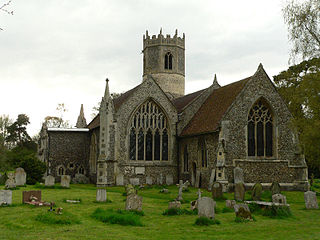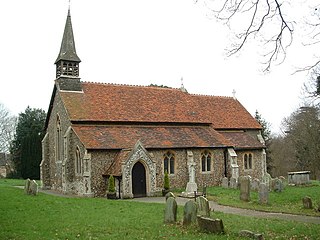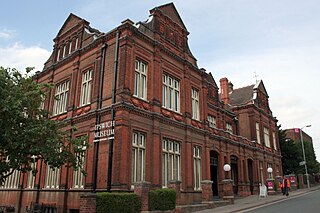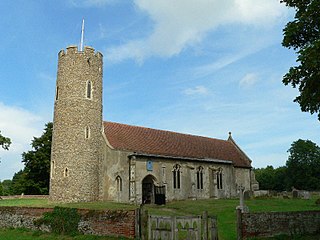
Woodbridge is a port town and civil parish in the East Suffolk district of Suffolk, England. It is 8 miles (13 km) up the River Deben from the sea. It lies 7 miles (11 km) north-east of Ipswich and around 74 miles north-east of London. In 2011 it had a population of 7749.

Sutton Hoo is the site of two Anglo-Saxon cemeteries dating from the 6th to 7th centuries near Woodbridge, Suffolk, England. Archaeologists have been excavating the area since 1938, when an undisturbed ship burial containing a wealth of Anglo-Saxon artifacts was discovered. The site is important in establishing the history of the Anglo-Saxon kingdom of East Anglia as well as illuminating the Anglo-Saxons during a period which lacks historical documentation.

Rickinghall Inferior is a civil parish in the Mid Suffolk district of Suffolk, England. According to the 2011 census there were 233 males and 216 females in this civil parish, for a total population of 449. It includes the western part of the village of Rickinghall and is adjacent to the village and parish of Wattisfield. The old road from the market town of Bury. St Edmunds to the City of Norwich and the town of Great Yarmouth passes through the centre of the village but the new road, the A143, uses a by-pass to the East.

Rickinghall Superior is a civil parish in the Mid Suffolk district of Suffolk, England. It covers the eastern part of the village of Rickinghall, and also the hamlets of Candle Street and Allwood Green. The estimated population of this civil parish in 2020 was 706.

Botesdale is a village and civil parish in the Mid Suffolk district of the English county of Suffolk. The village is about 6 miles (10 km) south west of Diss, 25 miles (40 km) south of Norwich and 16 miles (26 km) north east of Bury St Edmunds. The village of Rickinghall merges with Botesdale along the B1113 road, locally known as simply: ‘The Street’. Their connection creates the appearance of a single built-up residential area and the boundary between the two is difficult to identify.

Bucklesham is a village and civil parish in the East Suffolk district of Suffolk, England, a few miles east of Ipswich.

The Snape Anglo-Saxon Cemetery is a place of burial dated to the 6th century AD located on Snape Common, near to the town of Aldeburgh in Suffolk, Eastern England. Dating to the early part of the Anglo-Saxon Era of English history, it contains a variety of different forms of burial, with inhumation and cremation burials being found in roughly equal proportions. The site is also known for the inclusion of a high status ship burial. A number of these burials were included within burial mounds.

Ipswich Museum is a registered museum of culture, history and natural heritage, located in a Grade II* listed building on High Street in Ipswich, the county town of Suffolk. It was historically the leading regional museum in Suffolk, housing collections drawn from both the former counties of East Suffolk and West Suffolk, which were amalgamated in 1974.

Redgrave is a village and civil parish in Suffolk, England, just south of the River Waveney that here forms the county boundary with Norfolk. The village is about 4+1⁄2 miles (7 km) west of the town of Diss. The 2011 Census recorded the parish population as 459.

Rendlesham is a village and civil parish near Woodbridge, Suffolk, United Kingdom. It was a royal centre of authority for the king of the East Angles. The proximity of the Sutton Hoo ship burial may indicate a connection between Sutton Hoo and the East Anglian royal house, the Wuffingas. The king of Essex, Swithhelm who reigned from 660 to around 664, was baptised at Rendlesham by Bishop Cedd with King Æthelwold of East Anglia acting as his godfather. He died around the time of the great plague of 664 and may have been buried at the palace of Rendlesham.

Frostenden is a village and civil parish in the East Suffolk district of the English county of Suffolk. It is around 8 miles (13 km) south-west of Lowestoft and 3.5 miles (5.6 km) north-west of Southwold and lies on the A12 road between Wrentham and Wangford. Neighbouring parishes include Wrentham, Sotterley, Uggeshall, Wangford with Henham, Reydon and South Cove.
Basil John Wait Brown was an English archaeologist and astronomer. Self-taught, he discovered and excavated a 6th-century Anglo-Saxon ship burial at Sutton Hoo in 1939, which has come to be called "one of the most important archaeological discoveries of all time". Although Brown was described as an amateur archaeologist, his career as a paid excavation employee for a provincial museum spanned more than thirty years.
Edith May Pretty was an English landowner on whose land the Sutton Hoo ship burial was discovered after she hired Basil Brown, a local excavator and amateur archeologist, to find out if anything lay beneath the mounds on her property.

Wattisfield is a village and civil parish in the Mid Suffolk district of Suffolk in eastern England. Located on the A143 around seven miles south-west of Diss, in 2005 its population was 440, increasing to 475 at the 2011 Census.

The Sutton Hoo purse-lid is one of the major objects excavated from the Anglo-Saxon royal burial-ground at Sutton Hoo in Suffolk, England. The site contains a collection of burial mounds, of which much the most significant is the undisturbed ship burial in Mound 1 containing very rich grave goods including the purse-lid. The person buried in Mound 1 is usually thought to have been Rædwald, King of East Anglia, who died around 624. The purse-lid is considered to be "one of the most remarkable creations of the early medieval period." About seven and a half inches long, it is decorated with beautiful ornament in gold and garnet cloisonné enamel, and was undoubtedly a symbol of great wealth and status. In 2017 the purse-lid was on display at the British Museum.
Sutton is a village and a civil parish on the B1083 road, in the East Suffolk district, in the county of Suffolk, England. Sutton has a pub, a mobile post office and a place of worship. There is also the hamlet of Sutton Street and the Sutton Common estate nearby.

The Dig is a 2021 British drama film directed by Simon Stone, based on the 2007 historical novel of the same name by John Preston, which reimagines the events of the 1939 excavation of Sutton Hoo in Suffolk, England. It stars Carey Mulligan, Ralph Fiennes, Lily James, Johnny Flynn, Ben Chaplin, Ken Stott, Archie Barnes, and Monica Dolan.

Oulton is a civil parish on the western edge of the town of Lowestoft in the north of the English county of Suffolk. It is in the East Suffolk district. The eastern part of the parish forms part of the suburbs of Lowestoft, whilst the western section extends into The Broads national park, reaching the River Waveney and Oulton Dyke.

Tranmer House is a country house in Sutton Hoo, Woodbridge, Suffolk, England, dating from 1910. The house is located on the Sutton Hoo Anglo-Saxon burial site, and in 1938 was the home of Edith Pretty. In June 1938, Pretty employed Basil Brown to undertake the excavation of a range of burial mounds on the estate, leading to Brown's discovery in May 1939 of a ship burial, "one of the most important archaeological discoveries of all time". The house is now owned by the National Trust.
















